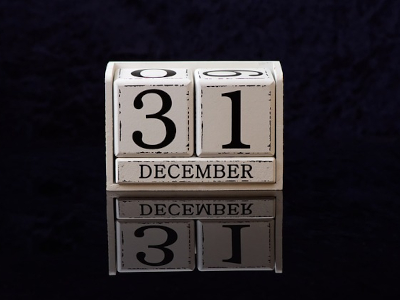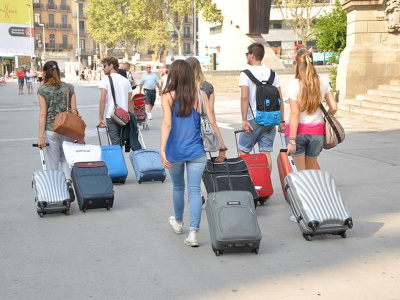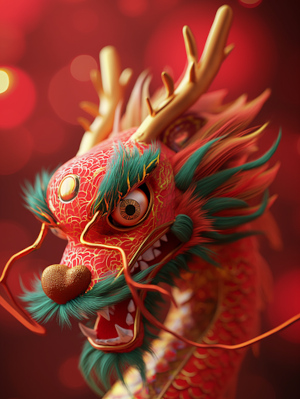New Year’s Eve is a special time for many, with unique traditions celebrated worldwide. This article contains 10 New Year traditions from different countries around the world.
India
India is a culturally diverse country, with different New Year festivals celebrated in each state. One of them is Ugadi, celebrated by the Telgu and Kannada communities. They decorate their homes with mango leaves and marigold flowers and enjoy Ugadi Pachadi, a dish with six different flavors symbolizing various emotions of life. Another is Rongali Bihu, celebrated in Assam. It is a spring festival where people dress in traditional attire and celebrate nature’s abundance with folk songs and Bihu dances. Furthermore, Puthandu, the Tamil New Year, is celebrated with rangolis and puja rituals. It begins with colorful art believed to bring good luck and prosperity, followed by a festive meal.
The Netherlands
Lots of people are running out of the sea in bright orange bobble hats for the New Year’s dive at Scheveningen. The tradition, known as Nieuwjaarsduik or the Polar Bear Plunge, is a popular way to start the New Year fresh in the Netherlands. Amsterdam also hosts New Year’s Eve street parties, with Dam Square being the wildest location. Enjoy music, fireworks, and oliebollen (oily balls) to keep evil spirits away in the New Year.
Colombia
On December 31st, many Colombians take their suitcases with them while running errands or going for a walk around the block at some point during the day. This is believed to ensure a year full of travel and adventures.
Iran
Iran celebrates the Persian New Year, Nowruz, on the spring equinox. One of the important traditions during this celebration is the Haft Seen, which represents the seven creations and the seven holy immortals. The Haft Seen consists of items that start with the letter “S,” such as apple, green grass, vinegar, wheat dish, berry, coin, and garlic. People also grow wheatgrass seeds as a reminder of the 7th feast of creation, symbolizing new growth and resurrection. Another tradition is jumping over bonfires while singing a traditional song, symbolizing purification and overcoming challenges from the previous year.
Cambodia
In Cambodia, people light candles and incense sticks to honor Buddha and pray for prosperity. They also wash their faces, chests, and feet with holy water for good luck. The second day involves making offerings to the less fortunate and attending ancestor dedication ceremonies. On the third day, statues of Buddha or elders are washed to symbolize washing away bad actions and bringing good luck, happiness, and prosperity. Additionally, there are traditional games and a giant water fight in the streets as part of the festivities.
Italy
In Italy, it’s a tradition to throw old furniture out of windows on New Year’s Eve to symbolize getting rid of bad memories from the past year and welcoming new beginnings. This tradition is especially popular in Naples. Today, many people only throw soft items out the window instead of heavy furniture.
China
In China, during Chinese New Year, people hang up lucky symbols like a dragon’s head to scare off a creature called Nian. This creature used to prey on villages every New Year. The bright colors, lights, and loud noises are now part of the celebration. People clean their homes, decorate with red symbols of good luck, and give red envelopes filled with money to younger, single people. There are dragon dances, firecrackers, and fireworks during the festivities. The Lantern Festival is also a popular event.
Ecuador
When celebrating New Year’s Eve in Ecuador, expect to witness a unique tradition involving burning effigies. These effigies, representing cultural figures or fictional characters, are set on fire by the locals. Additionally, some effigies are filled with paper and old photos. As the paper maché effigies burn, Ecuadorians bid farewell to negative experiences and ward off bad luck. Some individuals even take it a step further by jumping over the fire 12 times, symbolizing each month of the year.
Ethiopia
In Ethiopia, four women and girls are singing a traditional song while holding adey abeba flowers. The New Year, Enkutatash, is celebrated in September in Ethiopia. One of the reasons Enkutatash is celebrated in September is derived from the Bible, which states that heaven and earth were created in September. This month is special because it marks the beginning of spring and the equal length of daytime and nighttime hours on the 22nd of September. During the New Year celebrations, girls go from house to house singing the song “Abebayehosh” and carrying yellow adey abeba flowers. People also light a bonfire, burn ‘chibo’, and dance around it. Finally, they jump over the pit three times to symbolize leaving the old year behind and welcoming the new one.
Philippines
In the Philippines, round fruits are considered symbols of luck. Many people believe that having round objects on New Year’s Eve brings good fortune for the upcoming year. Examples of these objects include polka dots on clothes, placing circular fruits on the table, and carrying coins in your pocket. By embracing these round-shaped objects in their homes on New Year’s Eve, they invite luck and prosperity into their household.
Sources:
https://www.civitatis.com/blog/en/new-years-traditions-around-the-world/



